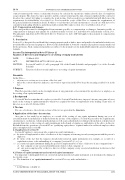Page 507 - SAIT Compendium 2016 Volume2
P. 507
IN 54 Income Tax acT: InTeRPReTaTIon noTes IN 55 (2)
contractor must pay the owner a certain sum of money for each day the operations continue after the date of completion as agreed upon. The clause becomes operative and the contractor must pay the sum of money stipulated if the contractor breaches the contract by failing to complete the work in time. Such a penalty is not unlawful and will likely meet the requirements for deductibility of section 11(a). It is beyond the scope of this Note to examine the requirements of the general deduction formula in detail. It suf ces to say that the facts and circumstances of each case will have to be considered in deciding whether a particular penalty is deductible under section 11(a) read with section 23(g).
4.2.3 Compensation and damages
Fines and penalties must be distinguished from amounts payable as compensation or damages. Amounts payable as compensation or damages may qualify for a deduction under section 11(a) and will not be denied under section 23(o). The principles laid down in Port Elizabeth Electric Tramway Co. Ltd v CIR*will apply to the payment of compensation or damages.
5. Conclusion
Section 23(o) has put it beyond doubt that corrupt payments such as bribes, nes and penalties for unlawful activities are not deductible for income tax purposes. However, the deductibility of bona de commercial penalties remains unaffected by the provision. Such commercial penalties are subject to the normal tests for deductibility under the general deduction formula.
Income Tax Interpretation Note 55 (Issue 2)
Taxation of directors and employees on vesting of equity instruments
DATE 30 March 2011
ACT: INCOME TAX ACT 58 OF 1962 (the Act)
SECTION: Section 8C and10 (1) (nD), paragraph 11A of the Fourth Schedule and paragraph 2 (a) of the Seventh Schedule
SUBJECT: Taxation of dierectors and employees on vesting of equity instruments
Preamble
In this Note—
• references to sections are to sections of the Act; and
• unless the context otherwise indicates, any word or expression in this Note bears the meaning ascribed to it in the
Act.
1 Purpose
This Note provides clarity on the tax implications of any gain made or loss incurred by any director or employee on the vesting of an equity instrument.
2 Background
Section 8C has been introduced to replace section 8A. Section 8C includes in a taxpayer’s income any gains or losses made on the vesting of equity instruments, which were acquired by virtue of employment or the holding of any of ce of director, on or after 26 October 2004.
3 The law
For ease of reference, the relevant sections of the Act are quoted in the Annexure.
4 Application of the law – Income tax
Any gain or loss made by an employee as a result of the vesting of any equity instrument during any year of assessment must be included in or deducted from the income of the employee. Section 8C prescribes the requirements, circumstances, exclusions, valuation methodology as well as procedural matters relating to the inclusion or deduction of amounts that relate to the vesting of equity instruments in the hands of employees and holders of the of ce of director. Excluded from the operations of section 8C are ‘qualifying equity shares’ acquired under a broad-based employee share plan contemplated in section 8B.
4.1 Application of section 8C
Section 8C applies to any person who acquired an equity instrument—
(a) by virtue of employment or of ce of a director of any company or from any person by arrangement with the person’s
employer;
(b) by virtue of the fact that the taxpayer already held restricted equity instruments (for example, as a result of a
capitalisation issue or the unbundling of a company) [section 8C (1) (a)]; or
(c) as a restricted equity instrument during the period of employment by or of ce of director of any company from—
(i) that company or any associated institution in relation to that company; or
(ii) any person employed by or that is a director of that company or any associated institution in relation to that
company.
4.2 Nature of equity instruments and restricted equity instruments
It is important to distinguish between a restricted and an unrestricted equity instrument as it determines the timing of the taxable event.
(a) The de nition of an ‘equity instrument’ in section 8C is very wide and includes—
* 1936 CPD 241, 8 SATC 13.
saIT comPendIum oF Tax LegIsLaTIon VoLume 2 499


